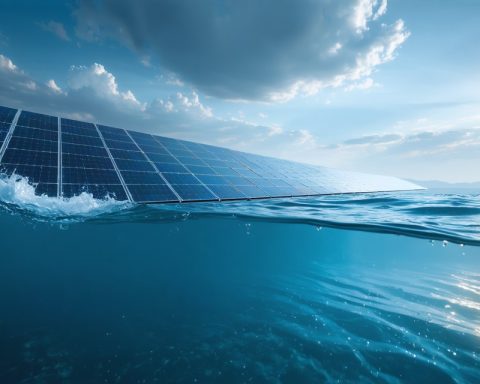- Ocean energy harnesses the power of waves, tides, and thermal gradients to generate clean electricity.
- This renewable energy source offers environmental benefits with a low carbon footprint and potential compatibility with marine ecosystems.
- Coastal areas, home to nearly 40% of the global population, are ideal for implementing ocean energy projects.
- Challenges include the ocean’s harsh environment and higher costs compared to other renewable sources, but advancements are ongoing.
- With further research and investment, ocean energy could become a major component of sustainable energy solutions.
Beneath sun-dappled waves, the sea holds secrets of boundless power. One might look out over an expanse of ocean, its rhythmic pulse as eternal as the stars, and see only the distant horizon. But innovators see a future lit by the very tides and currents that have run through our planet since time immemorial.
Imagine this: harnessing the relentless surge of ocean currents to power homes and businesses in bustling cities. Engineers and scientists are doing just that, crafting cutting-edge devices to tap into this sustainable energy source.
Coastal regions, home to nearly 40% of the world’s population, offer prime real estate for ocean energy projects. Imagine the bustling shores of New York, the iconic Golden Gate’s embrace, or even the sparkling beaches lining Sydney’s harbors—each vibrating with a gentle hum of energy generated by the moving sea.
The Science of Waves
Ocean energy technology utilizes the natural motion of waves, tides, and even ocean thermal gradients. Devices akin to submerged wind turbines capture kinetic energy as water ebbs and flows. These innovative machines, planted strategically on the ocean floor or riding the waves, transform the sea’s raw power into clean electricity.
To witness such a marvel is to watch the future unfold—a symphony of human ingenuity dancing in concert with nature’s timeless rhythm.
Eco-Friendly and Infinite
One cannot overstate the environmental benefits of harnessing ocean energy. Unlike fossil fuels, this energy is both renewable and boasts a remarkably low carbon footprint. Ocean energy devices coexist with marine ecosystems, offering the potential for symbiotic relationships with ocean life.
Moreover, the sheer scale of our oceans means they hold a virtually inexhaustible supply of energy. While weather conditions might hamper solar or wind efficiency, the ocean’s pulse is largely consistent, offering reliability seldom seen in other renewables.
A Challenge Worth Meeting
Yet, challenges remain. The salty embrace of the sea is harsh, demanding resilience from technological components. Costs, currently steeper than more established renewables, pose barriers, albeit surmountable ones. Innovators must continue to refine technology and scale-up production to drive costs down.
Regardless, the potential glittering on the horizon is too luminous to ignore. With continued investment and research, ocean energy can become a cornerstone of sustainable living.
Think of a future where the world’s coasts glow softly with light powered by the ocean’s heartbeat—a dream within our grasp.
Your Takeaway: The Sea’s Promise
As we seek solutions to the climate crisis, embracing a diverse portfolio of renewable energy sources is crucial. By investing in and supporting ocean energy, we inch closer to a sustainable future, one where nature’s gifts provide endlessly and harmoniously.
The time to ride the wave of ocean energy innovation is now. Burgeoning technology promises to unleash the sea’s power, lighting up the nights of coastal metropolises with the promise of a cleaner, greener tomorrow.
Unleashing Ocean Energy: Tapping the Sea’s Boundless Potential for a Sustainable Future
Exploring the Potential of Ocean Energy
Ocean energy presents a promising frontier in the quest for sustainable and renewable energy sources. As innovators delve into harnessing the sea’s power, several key aspects and potential impacts of this technology come to light.
How Ocean Energy Technologies Work
Ocean energy encompasses various technologies harnessing the power of ocean waves, tides, and thermal gradients:
– Wave Energy Converters: Devices that capture energy from the surface motion of waves. These might include point absorbers, attenuators, and oscillating water columns.
– Tidal Energy: Utilizes the natural rise and fall of tides. Tidal stream generators, which function like underwater wind turbines, are common.
– Ocean Thermal Energy Conversion (OTEC): Exploits temperature differences between cooler deep and warmer surface waters to generate power.
Real-World Use Cases and Benefits
1. Resilience in Coastal Communities: Ocean energy systems provide consistent power generation, making them ideal for remote and island communities often dependent on less reliable energy sources.
2. Global Capacity and Expansion: According to the International Renewable Energy Agency (IRENA), ocean energy has the potential to generate up to 300,000 terawatts per hour of power annually, vastly exceeding global electricity consumption today.
Challenges and Technological Advancements
While ocean energy holds immense promise, certain challenges need addressing:
– Durability and Maintenance: The ocean environment is harsh, requiring robust materials and designs that withstand corrosion and biofouling (accumulation of microorganisms and algae on surfaces).
– Cost Reduction: Initial capital expenditures are high compared to solar or wind energy. Scaling up production and technological advancements are critical to reducing costs.
Market Trends and Predictions
– Growing Investments: As of now, countries like the UK and Australia are leading in ocean energy projects. With increasing environmental awareness and government incentives, investment in ocean energy is projected to rise significantly over the next decade.
– Integration with Other Renewables: Combining ocean energy with solar and wind technologies can enhance grid reliability and efficiency, especially in regions with abundant natural resources.
Controversies and Limitations
– Environmental Concerns: Despite low carbon footprints, potential impacts on marine ecosystems remain a topic of debate. Collaborative research is essential to mitigate these effects and understand ecological interactions.
– Technological Maturity: Ocean energy technologies are still in the early stages compared to established renewables, requiring further development and demonstration projects.
Actionable Recommendations: Riding the Wave of Innovation
1. Support Research and Innovation: Investing in R&D to enhance efficiency and durability of ocean energy systems is critical. Governments and private sectors should collaborate in funding projects and incentivizing innovation.
2. Advocate for Policy Support: Encourage policies that support renewable energy adoption, such as tax credits and subsidies for ocean energy projects.
3. Community Engagement and Education: Raise awareness about the benefits and potential of ocean energy within local communities, fostering a culture of sustainability and innovation.
By embracing the vast potential of ocean energy, we edge closer to a future powered by clean and stable energy sources. The ocean’s pulse, eternal and powerful, beckons us to harness its energy and illuminate a sustainable path forward.
For more information on renewable energy solutions, visit the International Renewable Energy Agency.

















